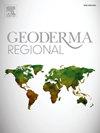Cashew residue biochar enhances the pore network of cohesive soil in the Brazilian Coastal Tablelands
IF 3.3
2区 农林科学
Q2 SOIL SCIENCE
引用次数: 0
Abstract
Soil physical quality is essential for agricultural productivity and environmental sustainability. Cohesive horizons often present high bulk density and low macroporosity, limiting water flow and aeration. This study evaluated the application of biochar derived from cashew residue as a conditioner to improve the physical quality of cohesive soils. We hypothesized that cashew residue biochar enhances soil (macro) porosity, pore connectivity, water retention, and water and airflow in cohesive horizons. The experiment was conducted with five biochar application rates (0, 5, 10, 20, and 40 Mg ha−1) in a randomized design, using disturbed soil samples manually packed into cylinders to ensure consistent bulk density. We analyzed the soil-water retention curve (SWRC), pore size distribution curve (PSDC), air permeability, pore continuity indices, and saturated hydraulic conductivity. Results demonstrated significant improvements in soil structure and pore functionality at higher biochar doses (20–40 Mg ha−1), despite the pore-blocking effect observed at these rates. The 40 Mg ha−1 treatment increased macroporosity by 15.3 %, while pore connectivity indices N and Log M rose by 34.2 % and 18.3 %, respectively. Available water improved by 9.1 %, and air permeability increased by 63.3 %, 45.0 %, 20.7 %, and 43.3 % at matric potentials of −6, −10, −33, and −100 kPa, respectively. Saturated hydraulic conductivity also increased by 18 % with the highest dose. These findings demonstrate the potential of cashew residue biochar to enhance the physical quality of cohesive soils, supporting more efficient soil management and sustainable agriculture. Applications between 20 and 40 Mg ha−1 are recommended to optimize improvements in soil physical properties.
腰果渣生物炭增强了巴西沿海高原粘性土壤的孔隙网络
土壤物理质量对农业生产力和环境可持续性至关重要。黏结层通常表现为高容重和低宏观孔隙度,限制了水流和通气性。本研究评价了腰果渣生物炭作为调理剂改善黏性土壤物理质量的应用。我们假设腰果渣生物炭可以增强土壤(宏观)孔隙度、孔隙连通性、保水能力以及黏结层中的水和气流。试验采用随机设计,采用5种生物炭施用量(0、5、10、20和40 Mg ha−1),将扰动土壤样品手动装入瓶中,以确保体积密度一致。分析了土壤保水曲线(SWRC)、孔隙尺寸分布曲线(PSDC)、透气性、孔隙连续性指数和饱和导水率。结果表明,在较高的生物炭剂量(20-40 Mg ha - 1)下,土壤结构和孔隙功能显著改善,尽管在这些剂量下观察到孔隙阻塞效应。40 Mg ha−1处理使宏观孔隙度提高15.3%,孔隙连通性指数N和Log M分别提高34.2%和18.3%。在基质电位为- 6、- 10、- 33和- 100 kPa时,有效水分增加了9.1%,透气性分别增加了63.3%、45.0%、20.7%和43.3%。饱和水力导电性在最高剂量下也增加了18%。这些发现表明腰果渣生物炭有潜力提高粘性土壤的物理质量,支持更有效的土壤管理和可持续农业。建议施用20至40 Mg ha - 1,以优化土壤物理性质的改善。
本文章由计算机程序翻译,如有差异,请以英文原文为准。
求助全文
约1分钟内获得全文
求助全文
来源期刊

Geoderma Regional
Agricultural and Biological Sciences-Soil Science
CiteScore
6.10
自引率
7.30%
发文量
122
审稿时长
76 days
期刊介绍:
Global issues require studies and solutions on national and regional levels. Geoderma Regional focuses on studies that increase understanding and advance our scientific knowledge of soils in all regions of the world. The journal embraces every aspect of soil science and welcomes reviews of regional progress.
 求助内容:
求助内容: 应助结果提醒方式:
应助结果提醒方式:


